Shyam Telecom DBHB-20-S8-S9 Dual Band Home Repeater DBHB-20-S8-S9 User Manual DBHB 20 Manual iDEN rev 03
Shyam Telecom Inc. Dual Band Home Repeater DBHB-20-S8-S9 DBHB 20 Manual iDEN rev 03
Users Manual
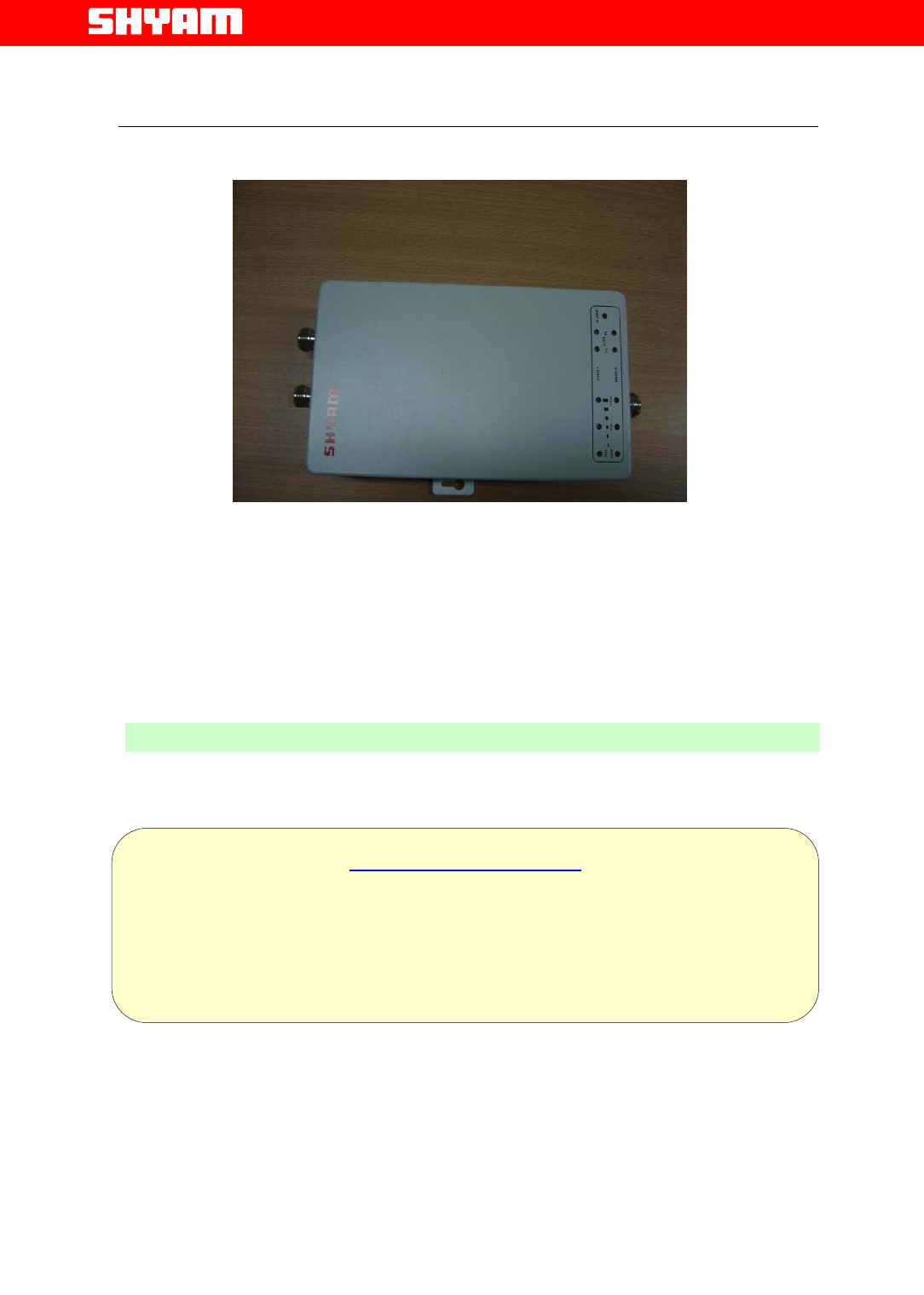
File Doc. No. Date Version Page
DBHB-20 5700 9004 055 Nov. 05 1.0 1/13
Next Generation
Signal Enhancement
Dual Band Home Booster
Model No.DBHB-20-S8-S9
I
IN
NS
ST
TA
AL
LL
LA
AT
TI
IO
ON
N
A
AN
ND
D
O
OP
PE
ER
RA
AT
TI
IO
ON
N
M
MA
AN
NU
UA
AL
L
`
D
DB
BH
HB
B-
-2
20
0 i
iD
DE
EN
N
Dual Band Home Booster 800 & 900 MHz
Proprietary Information
The information contained herein is proprietary to Shyam Telecom Limited. Use
or disclosure of this document or the information contained herein, for any purpose
other than that for which it was furnished is not permitted or it shall not be disclosed
or divulged to any third Party without the prior written consent of Shyam Telecom
Limited.
5700 9004 055 REV. 1.0 Nov 2005
SHYAM Telecom Ltd.
246, Phase-IV, Udyog Vihar Gurgaon-122015 (INDIA)
Tel: +91-124-5108830 Fax: +91-124-5018117 Email:
repeater@shyamtelecom.com
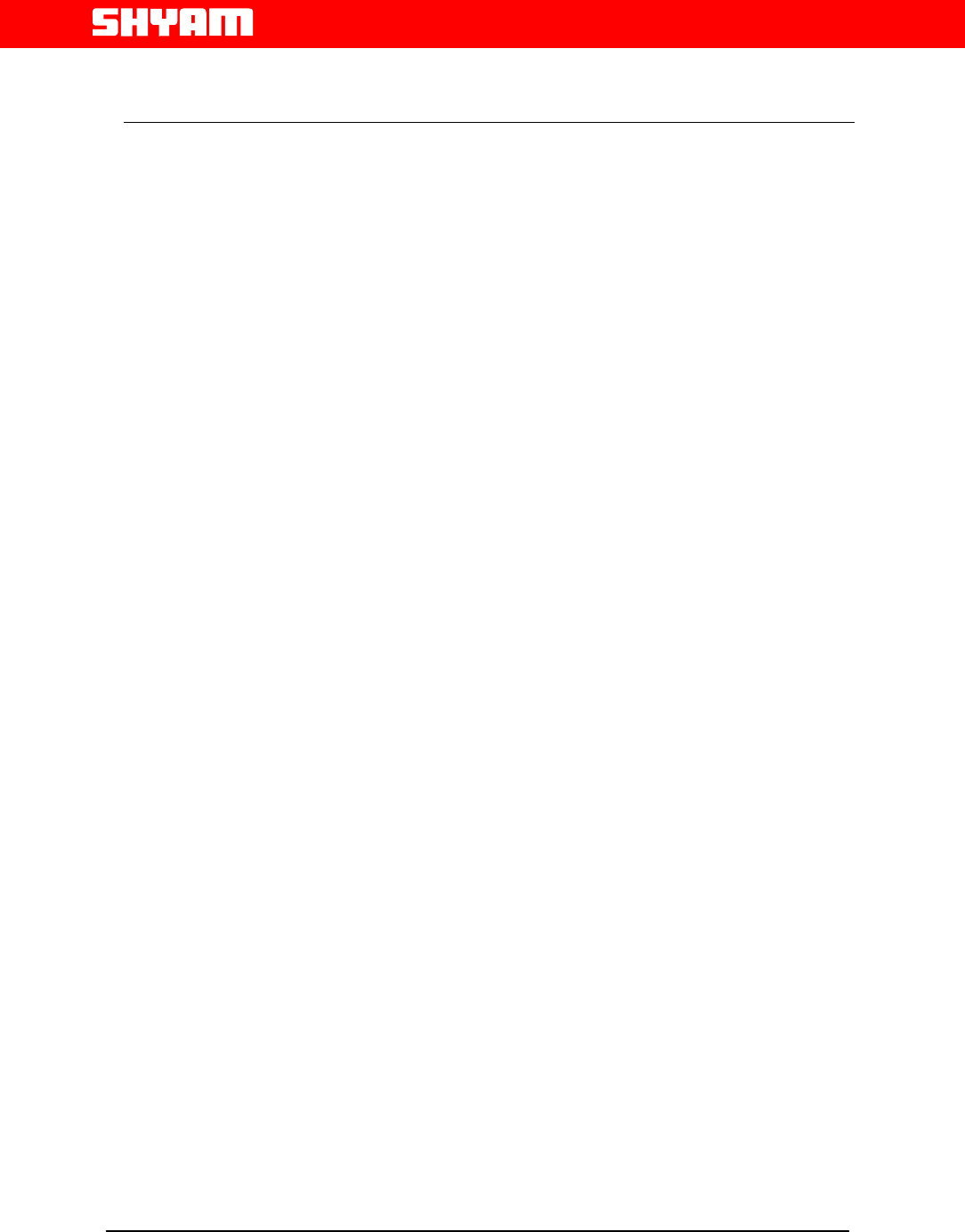
File Doc. No. Date Version Page
DBHB-20 5700 9004 055 Nov. 05 1.0 2/13
Next Generation
Signal Enhancement
Contents
PREAMBLE ................................................................................. 3
About the manual...................................................................... 3
1.0 About the manual................................................................. 4
2.0 Important Safety Information.................................................. 4
3.0 Introduction: Booster Theory / Background...................... 5
4.0 Description of DBHB-20 Booster installation Kit .............. 6
5.0 System Design and Setup ................................................... 7
6.0 Installing the DBHB-20 ........................................................ 7
6.1 Pre-installation considerations ............................................... 7
6.2 Installation Tools.................................................................. 7
6.3 Installation Procedure: Do It Yourself............................... 8
6.4 Power Startup / Alarm Checks / Coverage Testing........... 8
6.5 Display Details of DBHB-20................................................. 9
Technical Specification: Boosters DBHB-20 ............................ 10
Trouble shooting procedure DBHB-20 ..................................... 11
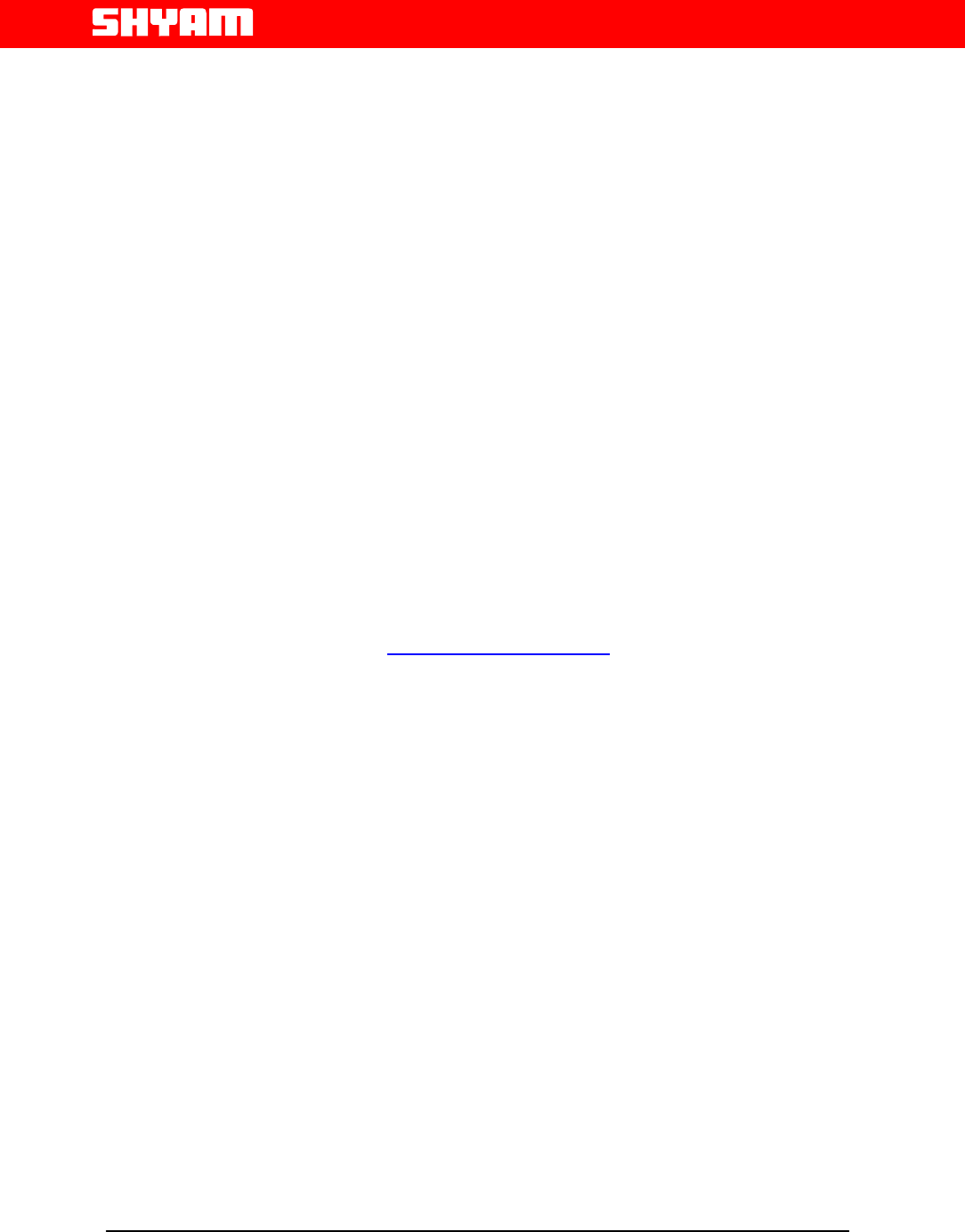
File Doc. No. Date Version Page
DBHB-20 5700 9004 055 Nov. 05 1.0 3/13
Next Generation
Signal Enhancement
PREAMBLE
In cellular systems boosters / repeaters are used, to enhance the coverage of a
Base station in a region where, due to topological conditions, poor field strengths
disable communication. SHYAM is a leading manufacturer of boosters /
repeaters. These boosters / repeaters provide excellent electrical characteristics,
are lightweight and easy to install.
Any intervention has to be performed by authorized persons only. If you need
technical assistance, please contact at the following address:
SHYAM Telecom Ltd.
246, Phase-IV, Udyog Vihar Gurgaon-122015 (INDIA)
Tel: +91-124-5108830 Fax: +91-124-5018117 Email:
repeater@shyamtelecom.com
Under consideration of all references given in this manual, the repeater should be
taken into service without any complications and should operate trouble free for a
long time.
However we have country wide after sales support network to assist you if
required.
Please visit to our web site www.shyamtelecom.com for our country wide after
sales support offices.
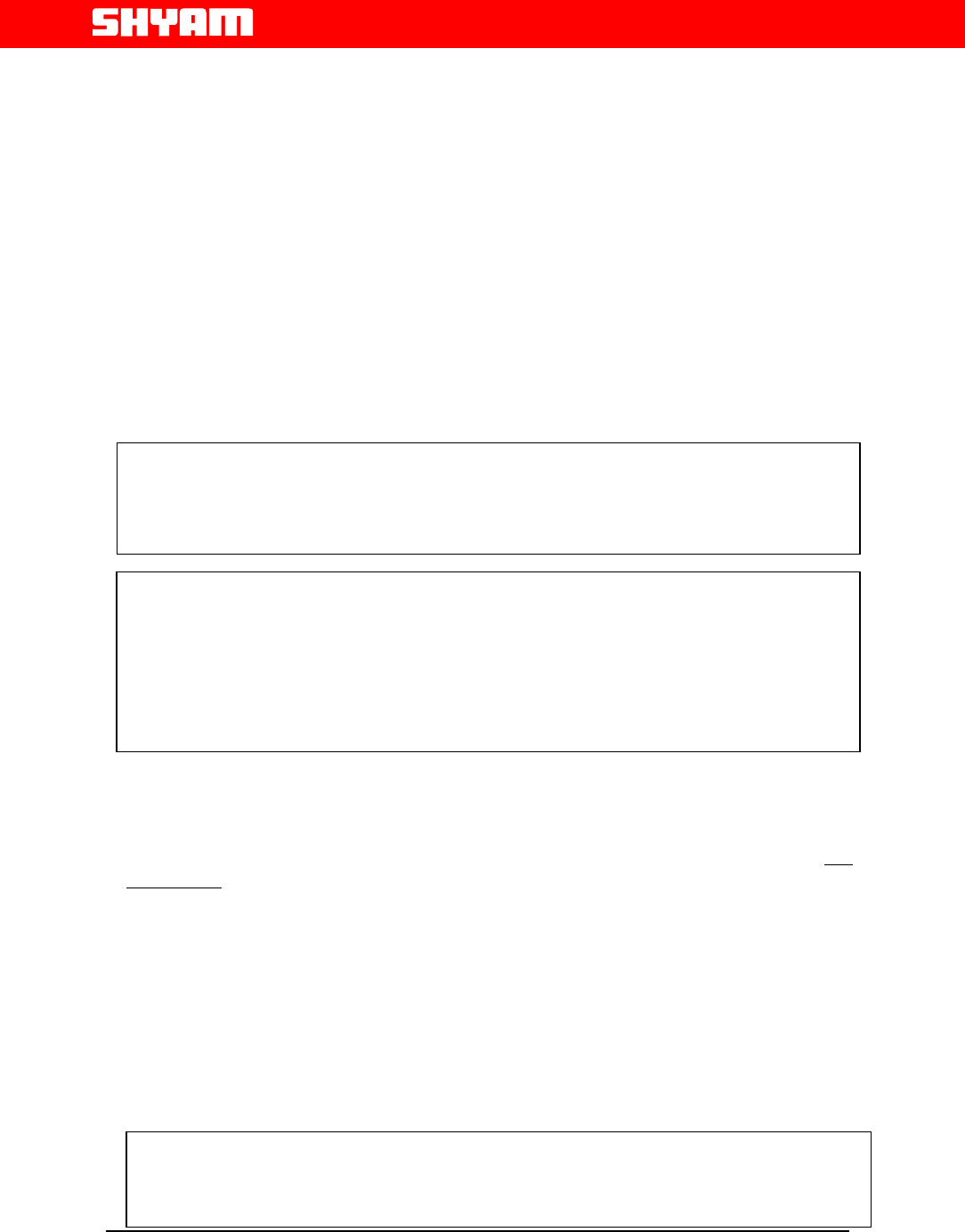
File Doc. No. Date Version Page
DBHB-20 5700 9004 055 Nov. 05 1.0 4/13
Next Generation
Signal Enhancement
1.0 About the manual
The “Installation and Operation manual” is intended to be used for SHYAM
DBHB-20 booster installation. It contains the general guidelines for the person
installing the DBHB-20 booster. Read carefully before starting the DBHB-20
booster installation.
2.0 Important Safety Information
The DBHB-20 booster has been designed for maximum safety when installed
and operated according to the instructions in this manual. Refer to all safety
instructions as per the antenna installation instruction sheets.
Do not bypass any of the safety features with the equipment provided, nor
operate the system in an inappropriate environment.
WARNING! Installation of antennas near power lines is dangerous. For your
safety, follow all installation directions and keep safe distance from any
high voltage power lines that could result in shock or loss of life.
WARNING! This equipment must not be co-located or operating in
conjunction with any other antenna or transmitter. The signal booster with
server antenna must be installed to provide minimum 20 cm separation
distance between the server antenna to the body of user or near by person.
The donor antenna used for this transmitter must be fixed-mounted on
outdoor permanent structures with a separation distance of at least 1.5
meters from all persons during normal operation.
Additional wiring required to install the DBHB-20 system should comply with
national or local governing Electrical Codes. Indoor RF coaxial cable installations
should comply with local Electrical Code requirements.
The DBHB-20 booster is designed for indoor application. The housing is not
waterproof, so please keep it away from water, rain and any chemical liquid.
Do discharge the static before you touch the connectors of the booster.
Do not open the module inside the booster unless you are authorized.
The power supply unit in the DBHB-20 booster is supplied from the mains
(primary AC power) that contain dangerous voltage level which will cause electric
shock, Please turn off the mains before you install / uninstall the booster.
The primary AC power should be in the range of AC90-270V, 50/60Hz. Booster
will be damaged if the primary AC power is out of the range.
The RF electric performance of the DBHB-20 booster conforms to ETSI
requirement of the inter modulation and spurious emission. It avoids the
interference problem.
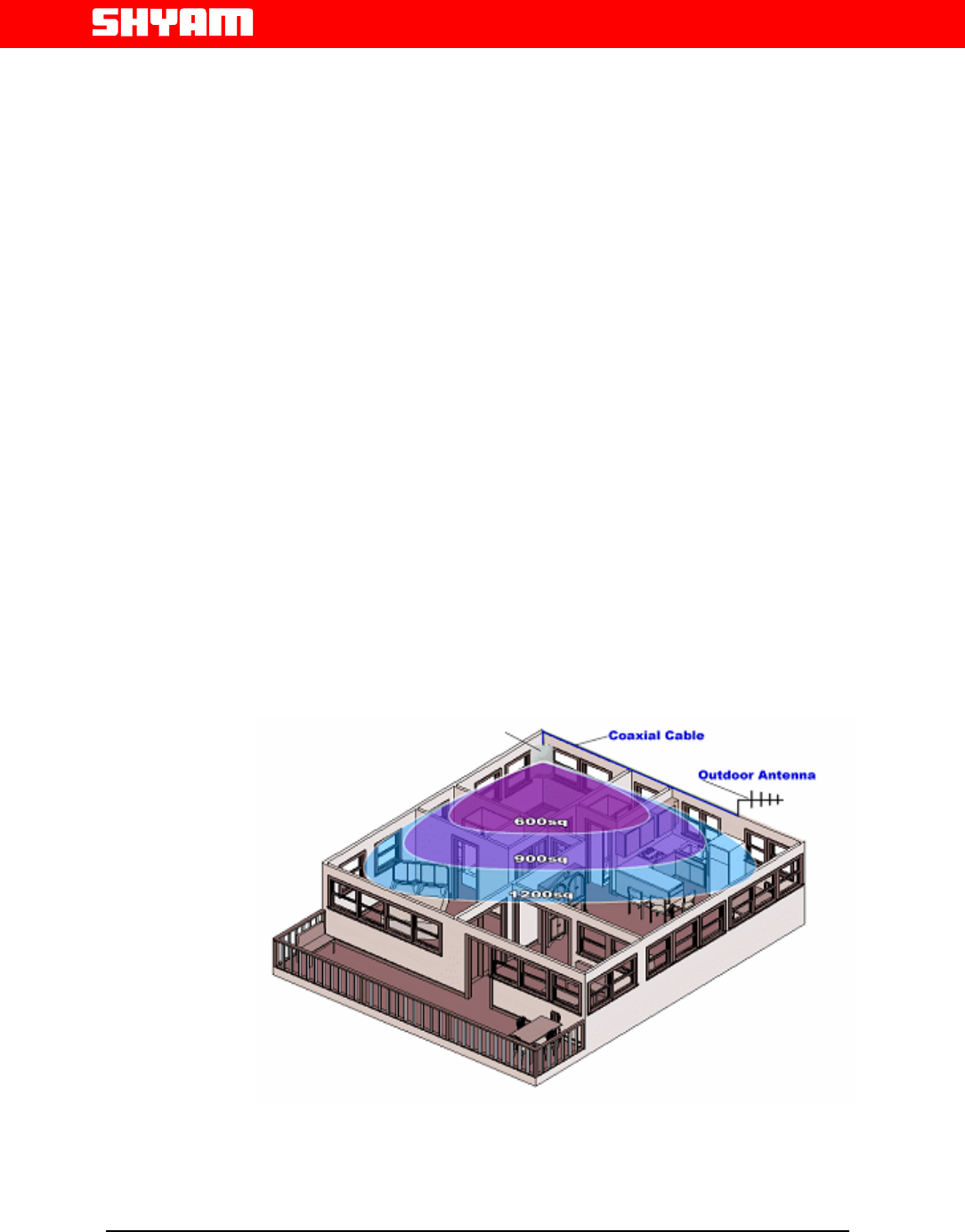
File Doc. No. Date Version Page
DBHB-20 5700 9004 055 Nov. 05 1.0 5/13
Next Generation
Signal Enhancement
3.0 Introduction: Booster Theory / Background
In mobile cellular communication system, boosters provide the radio frequency
(RF) coverage to areas, which either lack signal, or the required signal strength
for adequate mobile phone performance. To the typical user, this translates to the
inability to place or receive mobile phone calls in or out of the area, and in most
cases will result in a dropped call while entering into the poor coverage area.
Insufficient wireless coverage can occur both indoors and outdoors, and may
include indoor areas such as office buildings, parking garages, apartment
buildings, shopping malls, and residential homes. Outdoor areas are degraded by
geographic topologies such as mountains, valleys, dense foliage and high rising
urban landscapes which can easily degrade or obstruct the cell site’s signal from
the mobile phone.
The weak coverage problem can be solved by installing an active booster
system, designed for use in a multitude of installation configurations. Booster
systems provide an effective solution by redirecting, filtering and amplifying the
available signal at the donor antenna, into the weak coverage area, through a
properly selected interior coverage antenna. The illumination of the weak
coverage area allows the user’s handset to operate as intended within the
building or weak coverage area, while maintaining the user’s call clarity and
quality, which reduces service complaints and potential subscriber churn.
Figure 1: Typical Booster/Coverage Configuration
Booster
Antenna
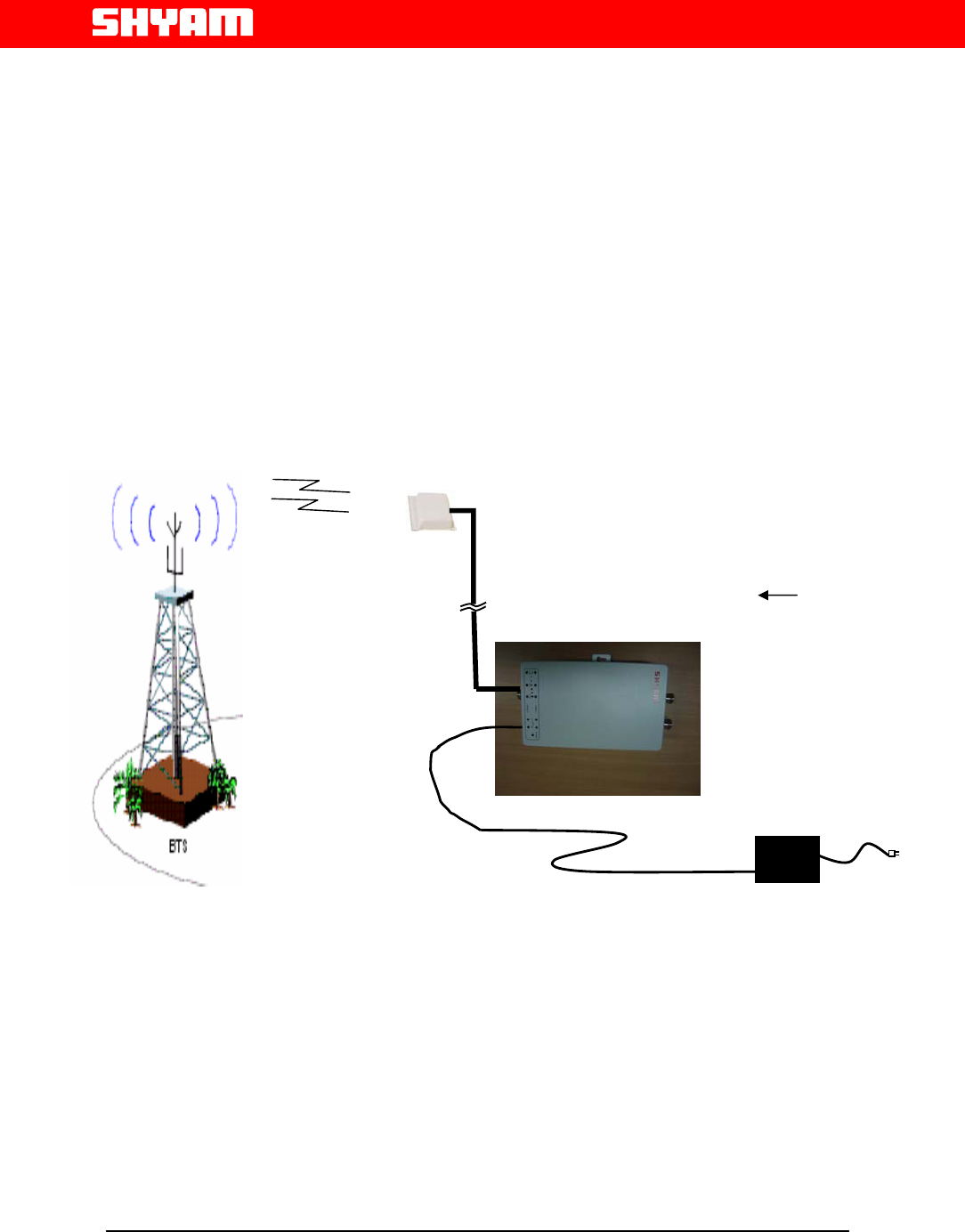
File Doc. No. Date Version Page
DBHB-20 5700 9004 055 Nov. 05 1.0 6/13
Next Generation
Signal Enhancement
4.0 Description of DBHB-20 Booster installation Kit
The DBHB-20 booster system contains an automatic power control, bi-
directional amplifier (BDA) supplied along with a donor antenna (highly directive
outdoor antenna) and server antenna (indoor omni directional antenna),
specifically designed for interior configurations. The donor antenna must be
pointed toward the cell of the base station from where the signal is to be picked
up and is usually mounted on the exterior of the building so as to receive the
maximum forward signal level from the base station. The indoor antenna of
DBHB-20 booster provides RF signal in all directions downward and outward
from the installation point.. A adopter is supplied with DBHB-20, powered by
universal 90/270 VAC mains supply. A standard length of 30 ft. RF coaxial cable
with connectors is supplied to connect the donor antenna and DBHB-20 booster.
Any other RF coaxial cable length is also available optionally, on request.
.
Figure 4.0 : Installation Diagram of Home Booster
List of Installation Kit
1. Donor Antenna – Patch Antenna (Optional 7 dbi)
2. Server Antenna - Whip Antenna. (Optional 0 dbi )
3. RF coaxial cable with N to SMA (M) connector. (Optional)
4. Booster DBHB-20.
5. AC/DC Adapter (9VDC/3.0 Amp.).
6. Mounting Kit.
7. Installation and Operational Manual
Donor Antenna
Coaxial Cable
+9V DC
AC/DC
Adapter
Donor Antenna
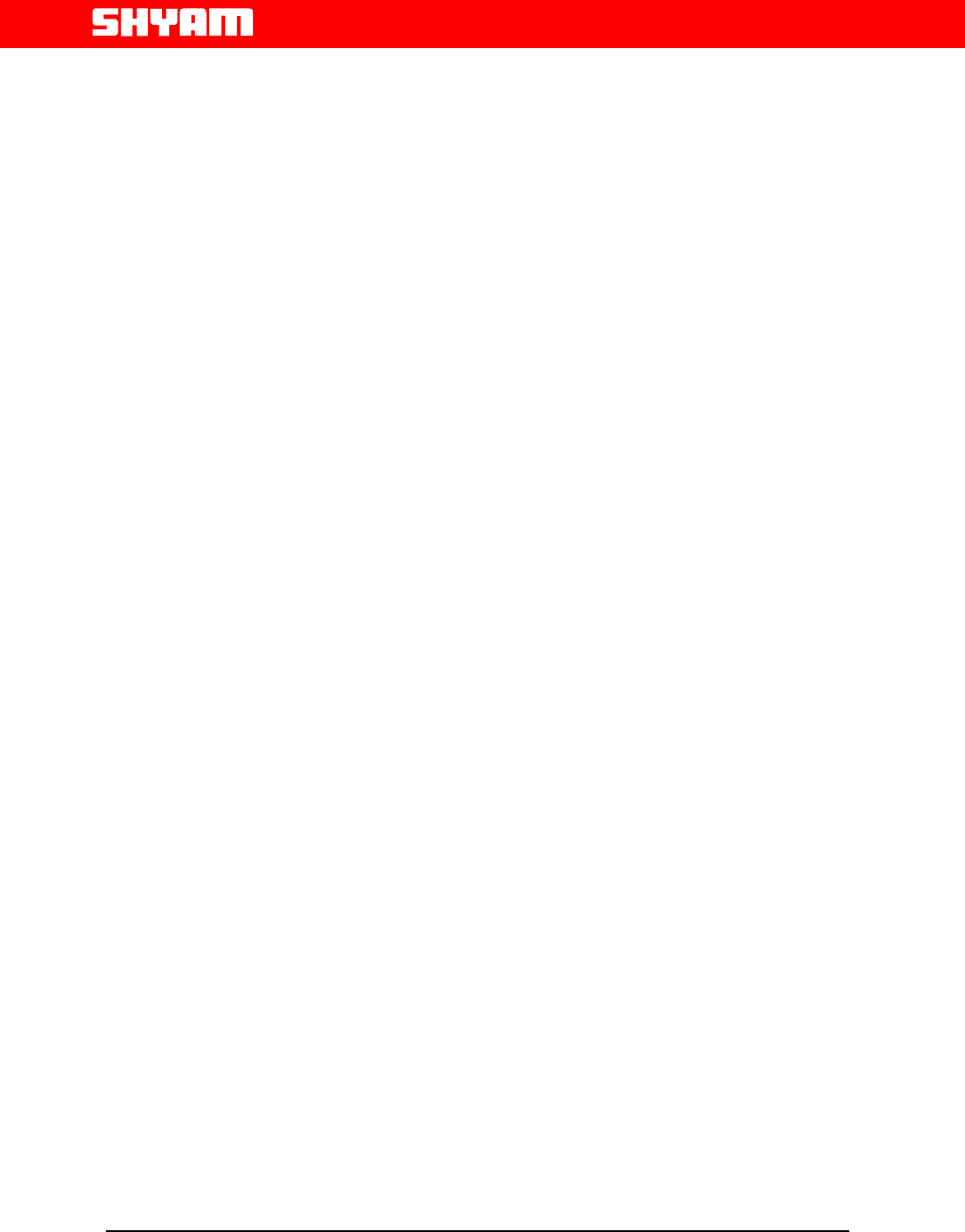
File Doc. No. Date Version Page
DBHB-20 5700 9004 055 Nov. 05 1.0 7/13
Next Generation
Signal Enhancement
5.0 System Design and Setup
The DBHB-20 is designed to provide optimal coverage for areas of 500 Sq
Meters (5,000 sq. ft). However, performance also depends on the amount of in-
building shadowing, and the available forward signal level at the donor antenna.
Typical coverage is usually planned for relatively small areas such as large
conference room or several adjacent rooms in smaller office areas. Indoor
coverage varies greatly due to the nature of various building construction
techniques and materials.
The system design is quite simple & straightforward. The signal from the base
station (of the selected Operator) is picked up, preferably on the rooftop.
The built in receive signal level indicator in DBHB-20 booster helps in aligning the
donor antenna towards the selected base station & it always shows the received
signal level from the base station. It is imperative to monitor the received signal
level from the base station, also called downlink signal. Downlink signal may
change if some high building, trees or any other obstruction comes in the way of
line of site (LOS) between the BTS & the Donor antenna. This may reduce the
downlink received signal level & will result in poor service.
6.0 Installing the DBHB-20
6.1 Pre-installation considerations
1. Once the expected coverage area is determined, identify the installation
location for the donor antenna and DBHB-20 booster. Ensure that the
donor antenna has a direct line-of-site to the service provider’s base
station.
2. DBHB-20 installation site location criterion
i. A cool, dry location, away from other heat generating appliances or
equipment.
ii. Accessibility to electric power point.
iii. Flat, structural mounting surface.
iv. Accommodation for the indoor antenna providing line-of-site coverage to
as much of the coverage area as possible.
6.2 Installation Tools
You will only need the standard wrenches/hammer/screwdrivers/pliers set
for installing the DBHB-20 booster and donor antenna.
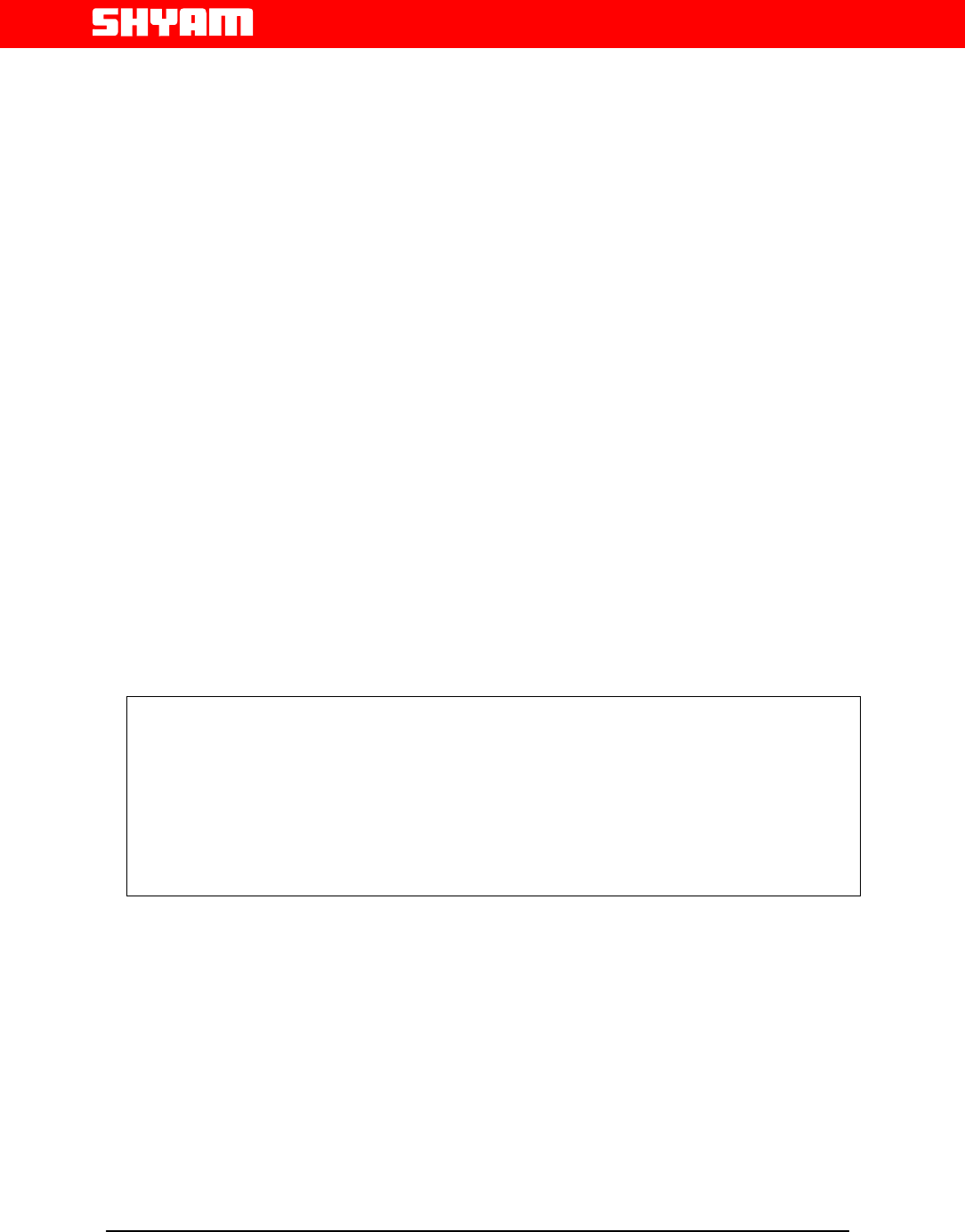
File Doc. No. Date Version Page
DBHB-20 5700 9004 055 Nov. 05 1.0 8/13
Next Generation
Signal Enhancement
6.3 Installation Procedure: Do It Yourself
To install DBHB-20 booster, follow the steps as mentioned below:
1. Locate weak signal areas by moving around with a mobile phone and the
SIM card of the cellular operator, and check the signal level indicated by
the number of bars on the mobile phone display.
2. Similarly, locate donor (outdoor) antenna position by observing the
maximum signal received from the base station.
3. Unpack the equipment supplied and check as per the packing list.
4 Mount the donor (outdoor) antenna at the position selected (ref 2 above).
5 Mount the DBHB-20 booster in the area of weak signal (ref 1 above)
6 Route the RF coaxial cable and interconnect it with the donor
antenna and DBHB-20 booster, which is supplied in the installation
kit.
7 Ensure that the three-pin power point has proper earthing
connection, before switching on the power to booster.
Please remember the following important points:
i. The RF cable must not be kinked, cut or damaged in any way.
ii. Connect the RF cable to the donor antenna taking care to avoid cross
threading or stripping. The RF connections should be snug and tight.
iii. Seal the outdoor connectors with waterproof sealant (such as M–
seal) or the appropriate weather tight boot.
6.4 Power Startup / Alarm Checks / Coverage Testing
1. Plug in the AC/DC Power Adapter power cord to AC main and other side
DC plug insert 9V DC socket in Home Booster.
2. When the booster is ON initially all the LED’s will blink two times.
3. The system will automatically control the attenuation to keep the both uplink
and downlink output power at a constant level of 10dBm. The system will
insert or release the attenuation by 1dB step.
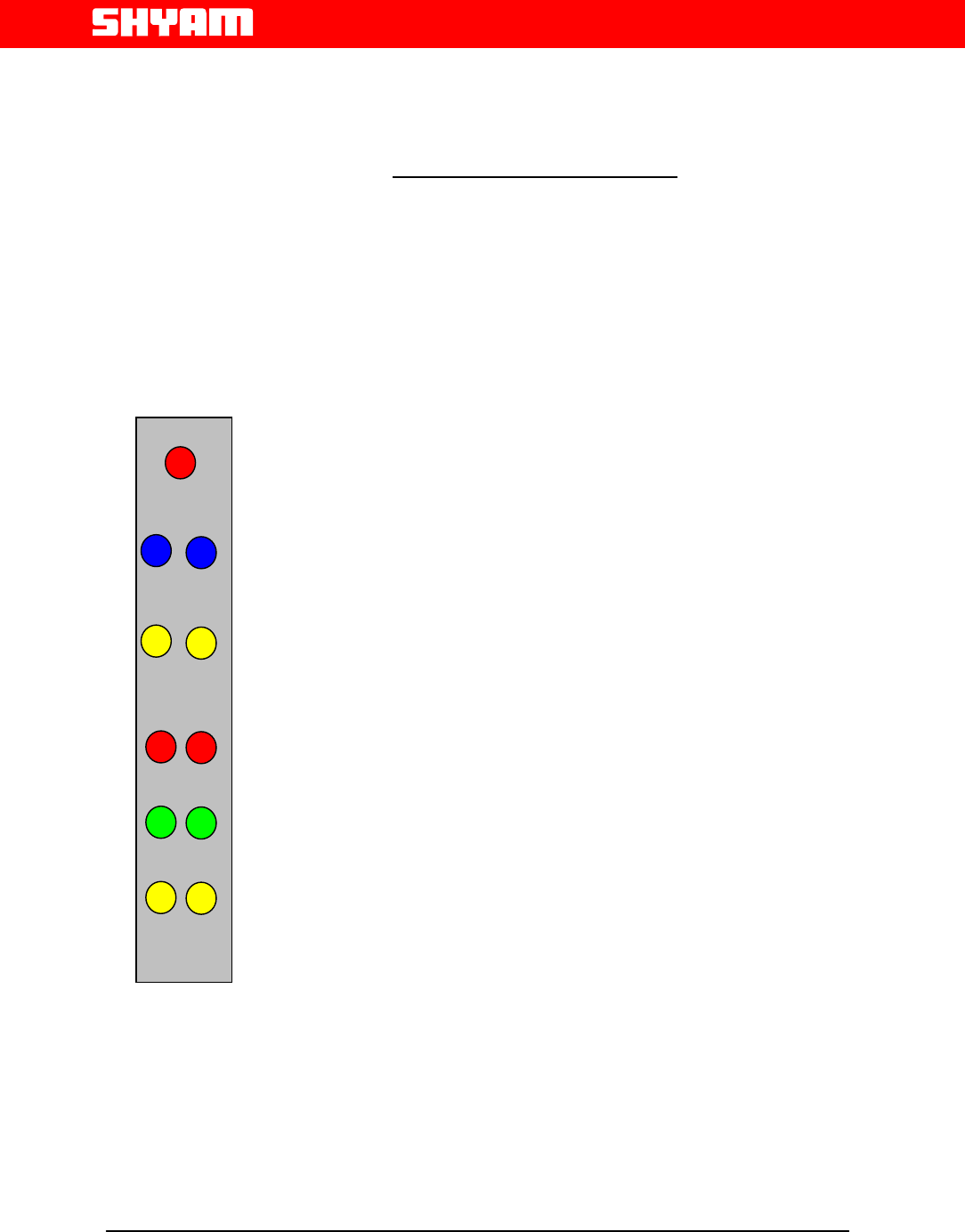
File Doc. No. Date Version Page
DBHB-20 5700 9004 055 Nov. 05 1.0 9/13
Next Generation
Signal Enhancement
4. Alarm indication LED will glow red color, After inserting all the attenuation
the output power is greater than the desired level ( 10dBm ) the system
will shutdown the PA for 30 seconds and restart . If so, refer annexure 2for
rectification or contact SHYAM technical support team on +91-11-
25798544 or email at repeater@shyamtelecom.com
5. Review the intended coverage area according to the site installation plan.
Using a mobile NOKIA handset loaded with NET engineering software and
the SIM card of cellular operator, measure and monitor the signal level at
various points within and around the perimeter of the coverage area.
6.5 Display Details of DBHB-20
SHUT DOWN LED will glow when the downlink power is more than the
desired level. The systems will shutdown the PA and then restart after 30
seconds.
• DL ALIGN LED will blink when the system is in the Downlink
alignment mode. When the alignment is over the DL ALIGN LED
will glow.
• UL ALIGN LED will glow after DL ALIGN is completed
Downlink RSSI is monitored continuously and display through 3
LED’s.
• When the RSSI is greater than –40, glow the RSL High LED.
• When the RSSI in between –60 & -40, glow the RSL Mid LED.
• When the RSSI is less than –60, glow the RSL Low LED.
U/L ALIGN
D/L ALIGN
RSL HIGH
RSL MID
RSL LOW
SHUT DOWN
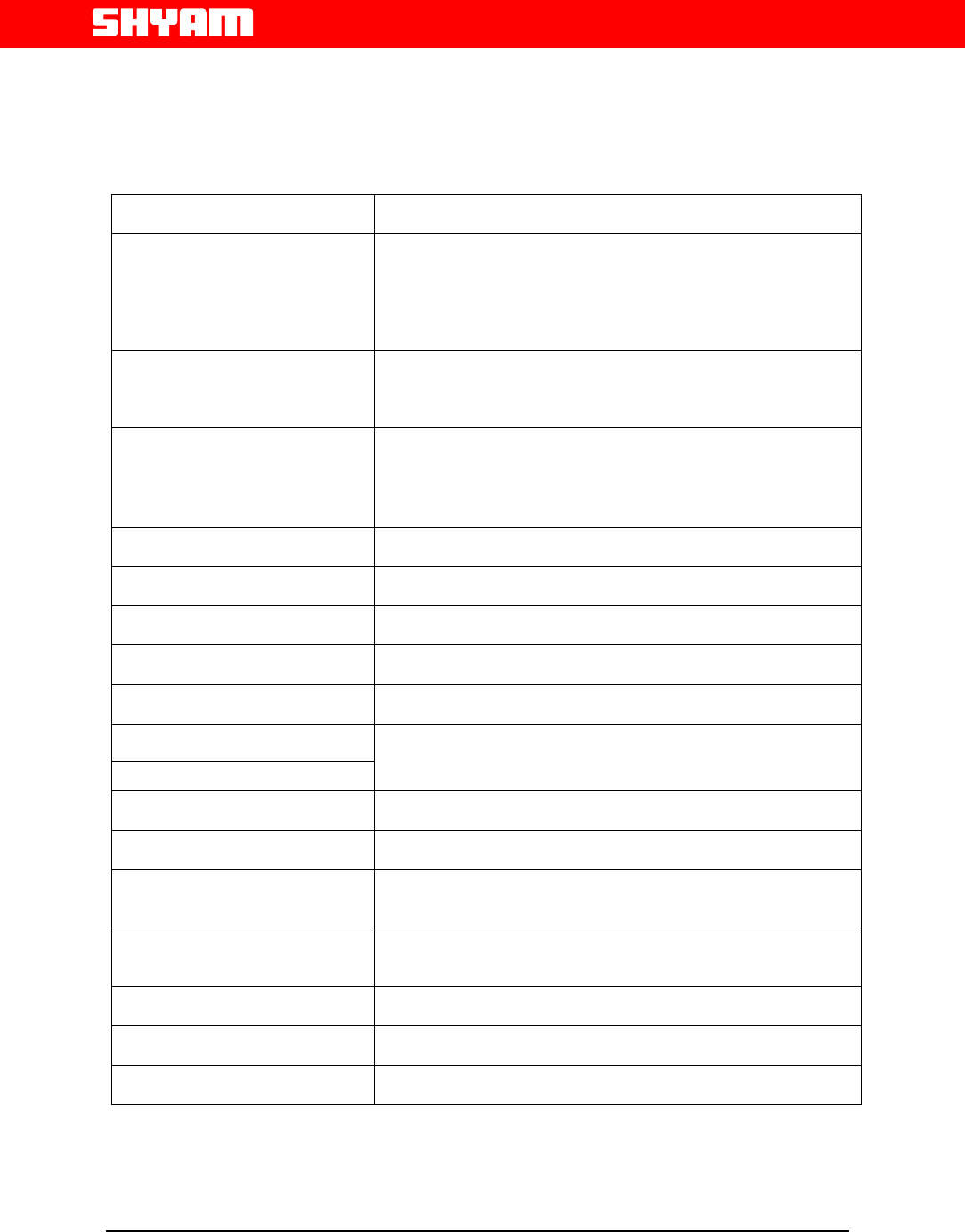
File Doc. No. Date Version Page
DBHB-20 5700 9004 055 Nov. 05 1.0 10/13
Next Generation
Signal Enhancement
Annexure 1
Technical Specification: DBHB-20
Parameter DBHB-20 : 800/900MHz
Frequency Range SMR Uplink : 806-824 MHz
SMR Downlink : 851-869 MHz
iDEN Uplink :896-901 MHz
iDEN Downlink :935-940 MHz
Frequency Bandwidth (Ver. A) SMR Full band of 18 MHz
iDEN 5 MHz for Nextel
Operator, State Selective
Version OSS
*Specific models for different operators world-wide
Contact SHYAM with coverage area & Operator name
Nominal Gain 65 dB Min in each band
Automatic Gain adjustment 31 dB steps of 1 dB
Auto Power Control range 10 dB
DL Composite Power Output /
Band / Antenna port +7 dBm
UL Composite Power Output /
Band / Antenna port +7 dBm
Inter Modulation Products
(two tone method, +4 dBm per tone)
Spurious Emission
-36 dbm
Noise Figure 8dB Max.
V.S.W.R 1.5 Max.
Power adapter (9V DC,/ 3.0 Amp.) AC90-270V, 50/60 Hz
RF Connector Donor Antenna
RF Connector Server Antenna
N (F)
Two o/p Ports N(F) & N(F)
Dimensions (LxWxD) approx. 86 x 53.5 x 32 inches
Weight Approx. 5.5 Lbs
Operating Temperature Range -31o F ~ 55o F
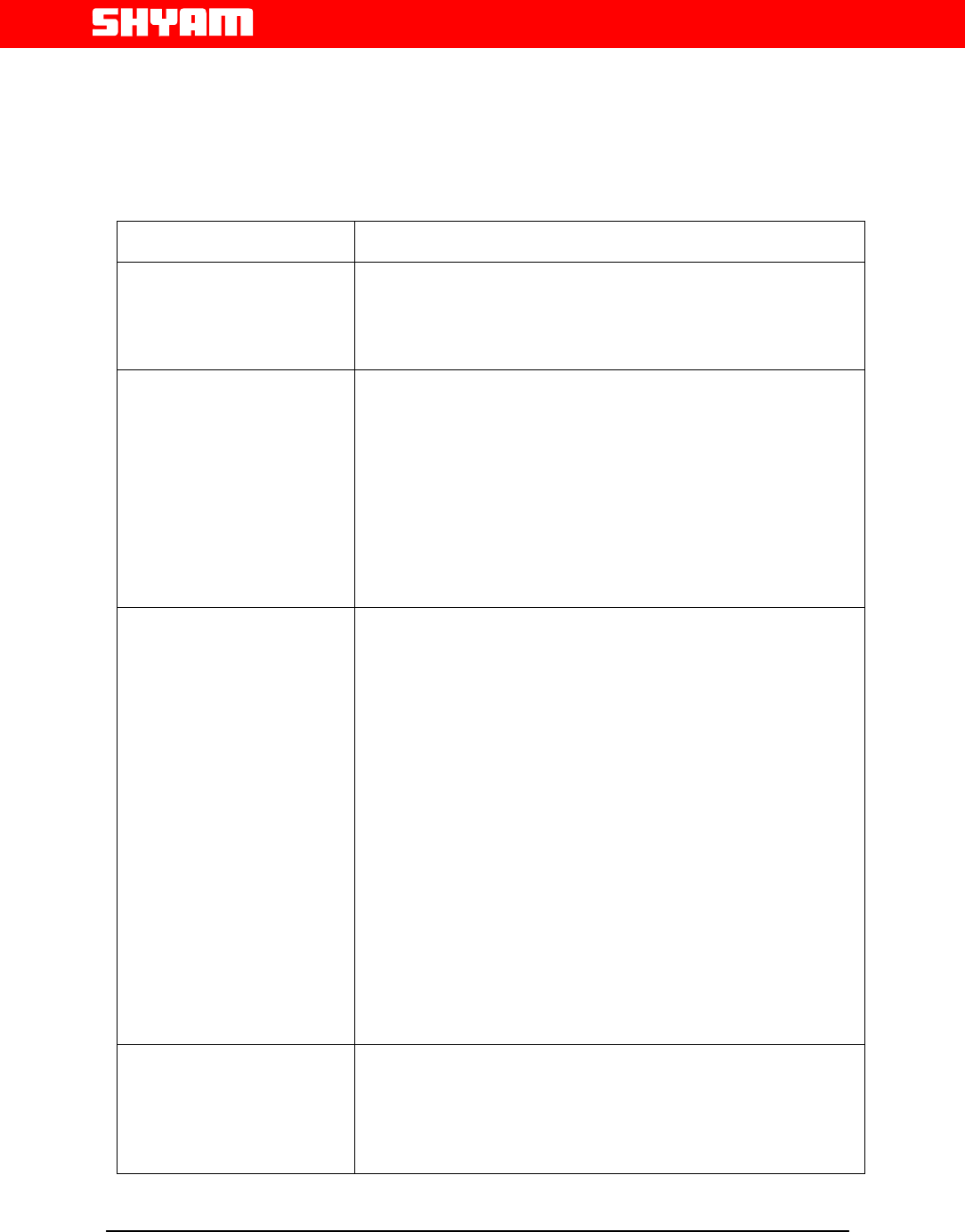
File Doc. No. Date Version Page
DBHB-20 5700 9004 055 Nov. 05 1.0 11/13
Next Generation
Signal Enhancement
Annexure 2
Trouble shooting procedure DBHB-20
Conditions Possible Reasons & Solutions
A. Initially all the LED’s
will blink two times
1 Check the power cord and the AC power socket
2 Please note that the AC main power has to be within the
range 90~270VAC
3 Verify the D.C Adapter output voltage is 9V.
B. Signals are not
amplified after
completing the
installation
1. Check all the connectors of the repeater system for proper
connections. The “BTS” connector has to be connected to
donor antenna, and the “MS” connector has to be
connected to server antenna.
2. The poor isolation between donor and server antenna will
cause system oscillation and it may damage the amplifier of
the repeater. It is to note that the repeater gain should
be at least 10 db lower than the antenna isolation.
C. The system performed
well in the beginning
but after few days the
performance has
degraded.
1. The received signal level from the base station might have
degraded due to environmental changes such as new
building construction and so on. If so, please follow the
suggestions below:
a. Try to re-align the donor antenna towards the base
station
b. Adjust the gain attenuation of the Up or Down link
direction
c. Relocate the donor antenna to solve the problem
2. RF Cable problem: Check the RF cable for physical
damage by rats etc. Also check for sharp bands or RF cable
pressed. Under these conditions, RF signal losses could
have increased. If so, replace RF cable.
3. Indoor structural change: The signal level will vary
according to the interiors. Look for any interior changes
subsequent to the repeater installation or site survey. If so,
adjust the gain of repeater or re-align the server antenna
without affecting the existing coverage.
D. Alarm indication LED
will glow in red colour.
It indicates that the received signal level from BTS is high or
forward / reverse gain of repeater is high. If alarm persists for a
long time contact SHYAM technical support team.
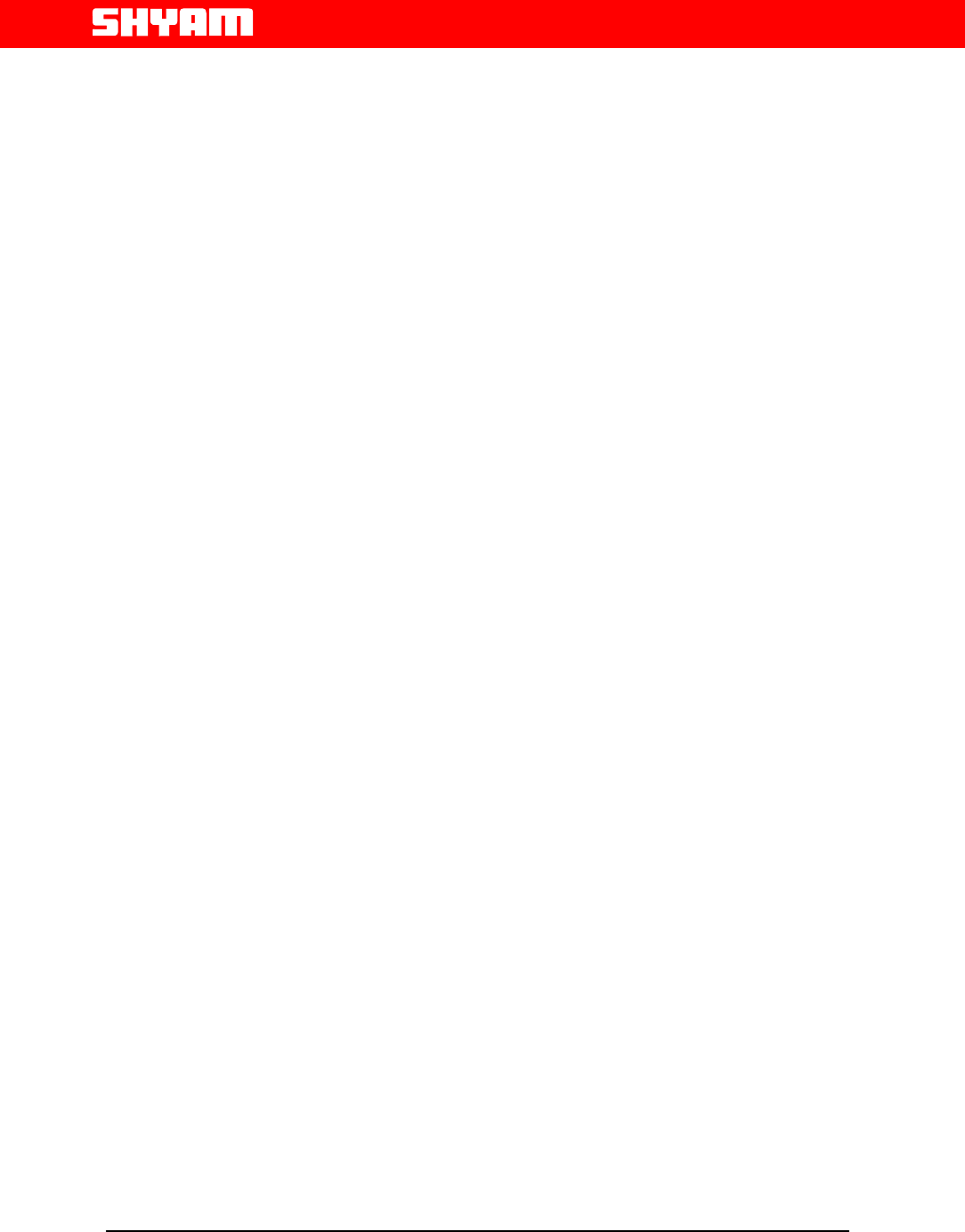
File Doc. No. Date Version Page
DBHB-20 5700 9004 055 Nov. 05 1.0 12/13
Next Generation
Signal Enhancement
Customers comments: